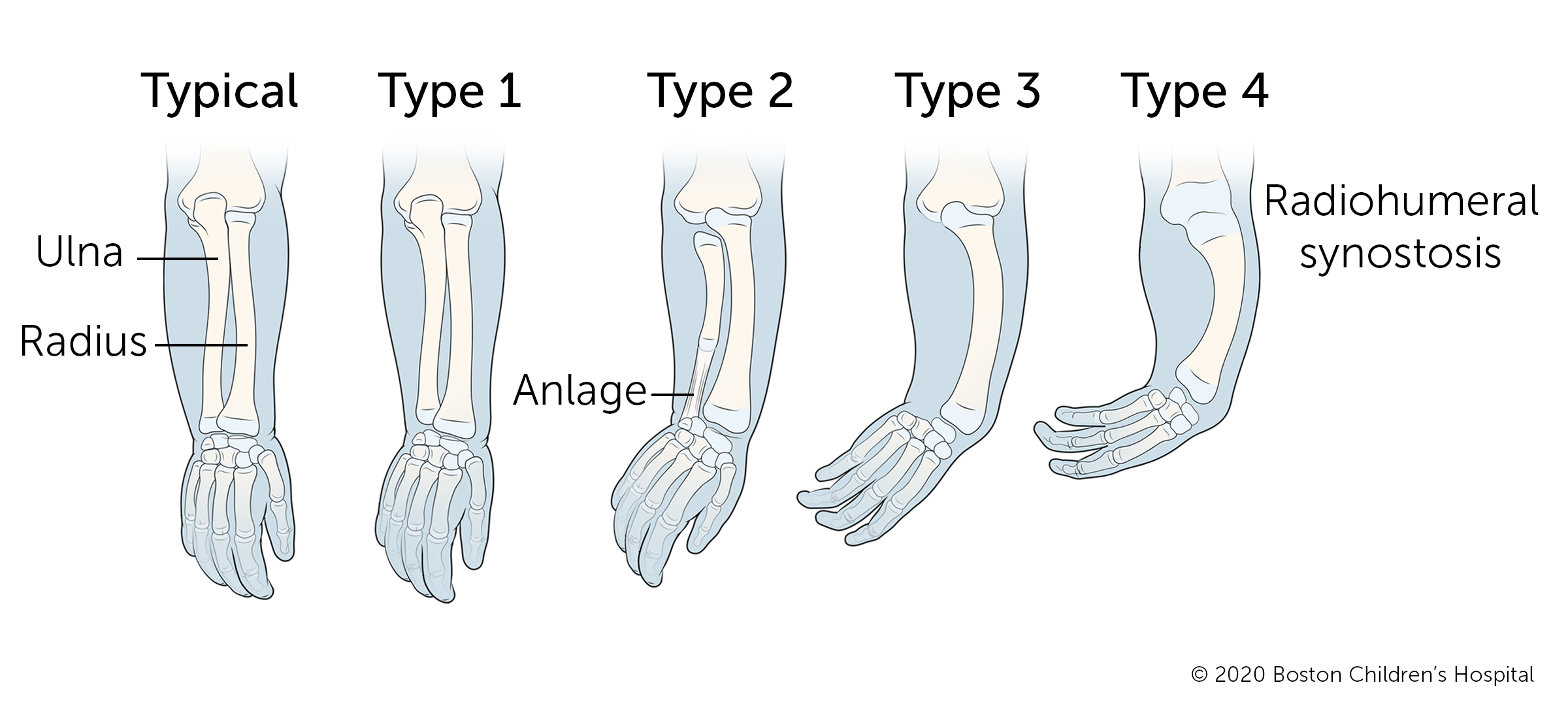Ulnar Longitudinal Deficiency | Symptoms & Causes
What are the symptoms of ulnar longitudinal deficiency?
There are four types of ulnar longitudinal deficiency based on the severity of the condition. Your child’s symptoms will depend on the type they have. If they have a mild form, their wrist may only bend out slightly. If they have a more severe type, their forearm may be significantly short and bowed outward toward their pinkie finger. Their hand and fingers may also be affected.

Types of ulnar longitudinal deficiency
- Type 1 is the mildest form of ulnar longitudinal deficiency. The ulna is slightly smaller than normal and the hand may have slight differences. This type causes few, if any, problems with a child’s development.
- Type 2 is the most common type of ulnar longitudinal deficiency. In children with this type, the ulna is partially missing and there is an abnormal bar of fibrous tissue called an anlage connecting the end of the ulna to the wrist. A child with this type may have some differences in their fingers or thumb, but their elbow is functional and stable.
- Type 3 ulnar longitudinal deficiency means a child does not have an ulna and their elbow is unstable. Many also have differences in the hand and wrist.
- Type 4 means a child is missing the ulna and has an abnormal connection between their humerus (the long bone in the upper arm) and radius. This connection, called a radiohumeral synostosis, fixes the elbow in one position. The forearm is significantly bowed and the hand and fingers are often affected as well.
What causes ulnar longitudinal deficiency?
Most of the time, the cause of ulnar longitudinal deficiency is unknown. It may sometimes run in families, particularly as part of an inherited syndrome, like ulnar mammary syndrome and Klippel Feil syndrome. It can also be associated with syndromes that are not inherited, like Cornelia de Lange syndrome.
Ulnar longitudinal deficiency is not caused by anything the mother did (or didn’t do) during her pregnancy. The condition is sometimes, but not always, picked up on a prenatal ultrasound. Even if it is detected prenatally, treatment always begins after your baby is born.
Ulnar Longitudinal Deficiency | Diagnosis & Treatments
How is ulnar longitudinal deficiency diagnosed?
To diagnose ulnar longitudinal deficiency, your child’s doctor will perform a complete physical exam to evaluate the arm and check for other orthopedic differences, such as scoliosis. They will note the severity of your child’s condition and will likely classify it as one of four types.
If the doctor suspects any associated problems, such as problems with the heart, kidneys, spine, blood cells, or digestive system, they may order additional tests.
How is ulnar longitudinal deficiency treated?
Your child’s treatment will depend on how severely their arm is affected by ulnar longitudinal deficiency.
Exercises and splinting
When your child is an infant, they may need stretching exercises and splinting to help improve alignment and range of motion in their forearm. Their doctor will guide you in performing gentle, passive-motion exercises for your child’s wrist and elbow.
Range-of-motion exercises are extremely important, even if your child will eventually need surgery. Any improvement in range of motion may make future surgery more effective and possibly less complex.
Your child may need to wear a splint at night throughout their infancy and during periods when they are growing quickly.
Surgical treatments
Some types of ulnar longitudinal deficiency can be improved with surgery. Surgery often includes operations on your child’s thumb and fingers to correct hand differences. A less common surgery repositions the arm to improve its function or stabilize the elbow.
What is the long-term outlook for children with ulnar longitudinal deficiency?
Your child’s long-term outlook depends on the severity of their condition. If they have a mild case, they will have only minor limitations in their arm’s mobility, strength, and function.
Children with more severe cases will have limited mobility, strength, and function in their arm. The growth of their arm will be limited as they get older. Ongoing occupational therapy can help your child address functional challenges as they grow and develop.
How we care for ulnar longitudinal deficiency at Boston Children’s Hospital
The Orthopedic Center’s Hand and Orthopedic Upper Extremity Program and our Department of Plastic and Oral Surgery’s Hand and Reconstructive Microsurgery Program have treated thousands of babies and children with ulnar longitudinal deficiency and other hand problems. We are experienced treating conditions that range from routine to highly complex, and can provide your child with expert diagnosis, treatment, and care. We also offer the benefits of some of the most advanced clinical and scientific research in the world.
Our Orthopedic Center is nationally known as the preeminent center for the care of children and young adults with a wide range of developmental, congenital, neuromuscular, sports-related, traumatic, and post-traumatic problems of the musculoskeletal system.
Our Department of Plastic and Oral Surgery is one of the largest and most experienced pediatric plastic and oral surgery centers anywhere in the world. We provide comprehensive care and treatment for a wide variety of congenital and acquired conditions, including hand deformities.

